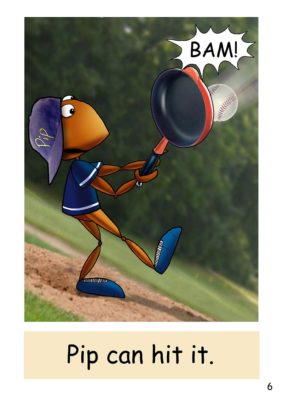‘Cat sat on mat….’
Critics of decodable books claim that they are boring and often don’t make sense. They quote examples like ‘Cat sat on mat. Pam sat on cat’… etc. They have a point! Many decodable books published in the past are repetitive and don’t exactly make sense. If the purpose of reading is to grasp the meaning of a text, reading a book which doesn’t make sense seems to defeat that purpose!
Fast forward 20 years and today decodable books are quite different. Since the crucial role of decodable books in the very early stages of reading was recognised, and they have become a required part of the curriculum in England, publishers have put their minds to improving the quality of these books.
Why control the text?
Decodable books are texts that are controlled by words that the beginner reader can decode. We want beginner readers to work out words by sounding them out. They can’t do this if the text has too many words with spellings they have not been taught, so they need to start with very simple words like ‘cat’. As they progress, words with more complex spellings are introduced. If we don’t limit the words in the books to those the kids can decode, they will revert to guessing! Guessing words is not reading and it is an ineffective reading strategy that should be discouraged.
Get the illustrations to work harder
So, how do you create a decodable book with such a limited word bank to engage, entertain and make sense? The trick is to get the illustrations to work with the text and deliver an experience that goes beyond the literal meaning of the words in the text.
Take a look at a page from Pip and the Bat from the Dandelion Launchers series.

Here is Pip, the ant. He is useless at hitting the ball with the bat, so he cleverly uses a frying pan. This book is from Unit (level) 2. The reader is expected to be able to blend (push sounds together into a word) the sounds s, a, t, i, m (sounds in Unit 1) and n, o, p (sounds in Unit 2). Imagine the exciting and empowering experience of being able to read a book independently with only eight letters/sounds of the alphabet.
So, to conclude: decodable books don’t need to be repetitive and they must make sense, but sometimes it is fun when they are a bit silly!


My 5 year old has books like this and she refuses to read them. I can’t blame her. They are dull, dull, dull. If you have a child whose ability to understand a story is based on a silly picture then they may work well. If you have a child who has been read proper chapter books and has an ability to understand an actual story, in fact loves stories – being read the stories, making up stories, having stories made up for her – then idiotic books like this are interminable. However the puddle lane books – with actual stories and “repeated” words for the kids to learn, which give them confidence are so much better. I wonder who had a vested interest in ensuring that amazing books like the puddle lane series are now out of print… You guys should be ashamed of yourselves. I was talking to a 13 year old recently who has to be forced to read. At 13. Not suprising if this is the kind of rubbish she was taught to read with. Its enough to kill any love of reading. My own daughter also hates reading at the moment as a result of books like this.
From a very frustrated mum
Hi Anna,
We are very sorry to hear that you are so frustrated with decodable books. Is your 5 year old reading the Phonic Books decodable books? If not, which books is she reading? If these are published by Phonic Books, this is disappointing to hear, as we have tried to make our books as fun and engaging as possible within the constraints of controlled texts that beginner readers can read independently.
As educators and reading specialists who have worked with many struggling readers, we have found that decodable books are empowering and that they consolidate the foundations of reading. Decodable books have a very limited but essential role to play in acquiring literacy: to consolidate letter/sound correspondences and to promote the habit of blending sounds into words. Once children have begun to use these tools successfully, and can apply them to any text they are reading, they can launch into reading authentic books. So, decodable books are intended for a very short period of time. If your daughter can read picture books on her own – she shouldn’t be reading decodable books. But if she it unable to and is guessing at words, she does. We recommend reading two kinds of books – one which is matched to the reading level of your daughter and another that you can read to her for all the wonderful reading experience books offer. You might be interested in a recent blog post I wrote about which books we suggest schools send home to support both reading skills (decoding) and the love of reading. https://www.phonicbooks.co.uk/2022/03/07/whats-in-your-book-bag/ Our best wishes, The Phonic Books Team
Thanks for your measured reply to my frustrated outburst 🙂